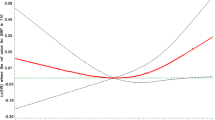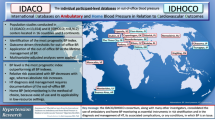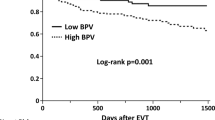Abstract
Blood pressure (BP) variability is associated with several cardiovascular (CV) risk factors. Is BP variability measurement of any additive value, in terms of CV risk assessment strategies? To answer this question, we analyzed data from the SU.FOL.OM3 secondary prevention trial that included 2501 patients with background of CV disease history (coronary or cerebrovascular disease). BP was measured every year allowing calculation of variability of BP, expressed as s.d. and coefficient of variability (s.d./mean systolic BP) in 2157 patients. We found that systolic BP variability was associated with several CV risk factors: principally hypertension, age, and diabetes. Furthermore, all antihypertensives were positively associated with variability. Logistic regression analysis revealed that three factors were independent predictors of major CV event: coefficient of variability of systolic BP (OR=1.23 per s.d., 95% CI: 1.04–1.46, P=0.016), current smoking (OR=1.94, 95% CI: 1.03–3.66, P=0.039), and inclusion for cerebrovascular disease (OR=1.92, 95% CI: 1.29–2.87, P=0.001). Finally, when comparing logistic regression models characteristics without, and then with, inclusion of BP variability, there was a modest but statistically significant improvement (P=0.04). In conclusion, age, BP and diabetes were the major determinants of BP variability. Furthermore, BP variability has an independent prognostic value in the prediction of major CV events; but improvement in the prediction model was quite modest. This last finding is more in favor of BP variability acting as an integrator of CV risk than acting as a robust independent CV risk factor in this high-risk population.
This is a preview of subscription content, access via your institution
Access options
Subscribe to this journal
Receive 12 digital issues and online access to articles
$119.00 per year
only $9.92 per issue
Buy this article
- Purchase on Springer Link
- Instant access to full article PDF
Prices may be subject to local taxes which are calculated during checkout

Similar content being viewed by others
References
Frattola A, Parati G, Cuspidi C, Albini F, Mancia G . Prognostic value of 24-hour blood pressure variability. J Hypertens 1993; 11: 1133–1137.
Sander D, Kukla C, Klingelhöfer J, Winbeck K, Conrad B . Relationship between circadian blood pressure patterns and progression of early carotid atherosclerosis: a 3-year follow-up study. Circulation 2000; 102: 1536–1541.
Sega R, Corrao G, Bombelli M, Beltrame L, Facchetti R, Grassi G et al. Blood pressure variability and organ damage in a general population: results from the PAMELA study (Pressioni Arteriose Monitorate E Loro Associazioni). Hypertension 2002; 39: 710–714.
Rothwell PM, Howard SC, Dolan E, O'Brien E, Dobson JE, Dahlöf B et al. Pronostic significance of visit-to-visit variability, maximal systolic blood pressure, and episodic hypertension. Lancet 2010; 375: 895–905.
Rothwell PM . Limitations of the usual blood-pressure hypothesis and importance of variability, instability, and episodic hypertension. Lancet 2010; 375: 938–948.
Rothwell PM, Howard SC, Dolan E, O'Brien E, Dobson JE, Dahlöf B et al. Effects of beta blockers and calcium-channel blockers on within-individual variability in blood pressure and risk of stroke. Lancet Neurol 2010; 9: 469–480.
Muntner P, Shimbo D, Tonelli M, Reynolds K, Arnett DK, Oparil S . The relationship between visit-to-visit variability in systolic blood pressure and all-cause mortality in the general population. findings for NHANES III, 1988 to 1994. Hypertension 2011; 57: 160–166.
Galan P, Kesse-Guyot E, Czernichow S, Briancon S, Blacher J, Hercberg S et al. Effects of B-vitamins and omega 3 fatty acids on cardiovascular diseases: a randomized placebo-controlled trial. BMJ 2010; 341: c6273.
Galan P, Briançon S, Blacher J, Czernichow S, Hercberg S . The SU-FOL-OM3 study. A secondary prevention trial testing the impact of supplementation with folate and B-vitamins and/or Omega-3 PUFA on fatal and non fatal cardiovascular events, design, methods and participants characteristics. Trials 2008; 9: 35.
Pencina MJ, D'Agostino RB Sr, D'Agostino RB Jr, Vasan RS . Evaluating the added predictive ability of a new marker: from area under the ROC curve to reclassification and beyond. Stat Med 2008; 27: 157–172.
Webb AJ, Fischer U, Mehta Z, Rothwell PM . Effects of antihypertensive-drug class on interindividual variation in blood pressure and risk of stroke: a systematic review and meta-analysis. Lancet 2010; 375: 906–915.
Acknowledgements
We thank all the health professionals, staff at the coordinating center and patients who participated in the SU.FOL.OM3 trial. We also acknowledge the expert help of Nathalie Arnault for statistical analysis and of Gwenael Monot for computer data management. The SU.FOL.OM3 study acknowledges financial support from the French Ministry of Research (R02010JJ), Ministry of Health (DGS), Sodexo, Candia, Unilever, Danone, Roche Laboratory, Merck EPROVA GS and Pierre Fabre Laboratory.
Author information
Authors and Affiliations
Corresponding author
Ethics declarations
Competing interests
The authors declare no conflict of interest.
Rights and permissions
About this article
Cite this article
Blacher, J., Safar, M., Ly, C. et al. Blood pressure variability: cardiovascular risk integrator or independent risk factor?. J Hum Hypertens 29, 122–126 (2015). https://doi.org/10.1038/jhh.2014.44
Received:
Accepted:
Published:
Issue Date:
DOI: https://doi.org/10.1038/jhh.2014.44
This article is cited by
-
Predictive value of visit-to-visit blood pressure variability for cardiovascular events in patients with coronary artery disease with and without diabetes mellitus
Cardiovascular Diabetology (2021)
-
Effects of white-coat, masked and sustained hypertension on coronary artery stenosis and cardiac arrhythmia
Hypertension Research (2020)
-
Blood pressure variability: its relevance for cardiovascular homeostasis and cardiovascular diseases
Hypertension Research (2020)
-
Visit-to-Visit Variability of Systolic Blood Pressure and Cardiovascular Disease
Current Hypertension Reports (2015)



